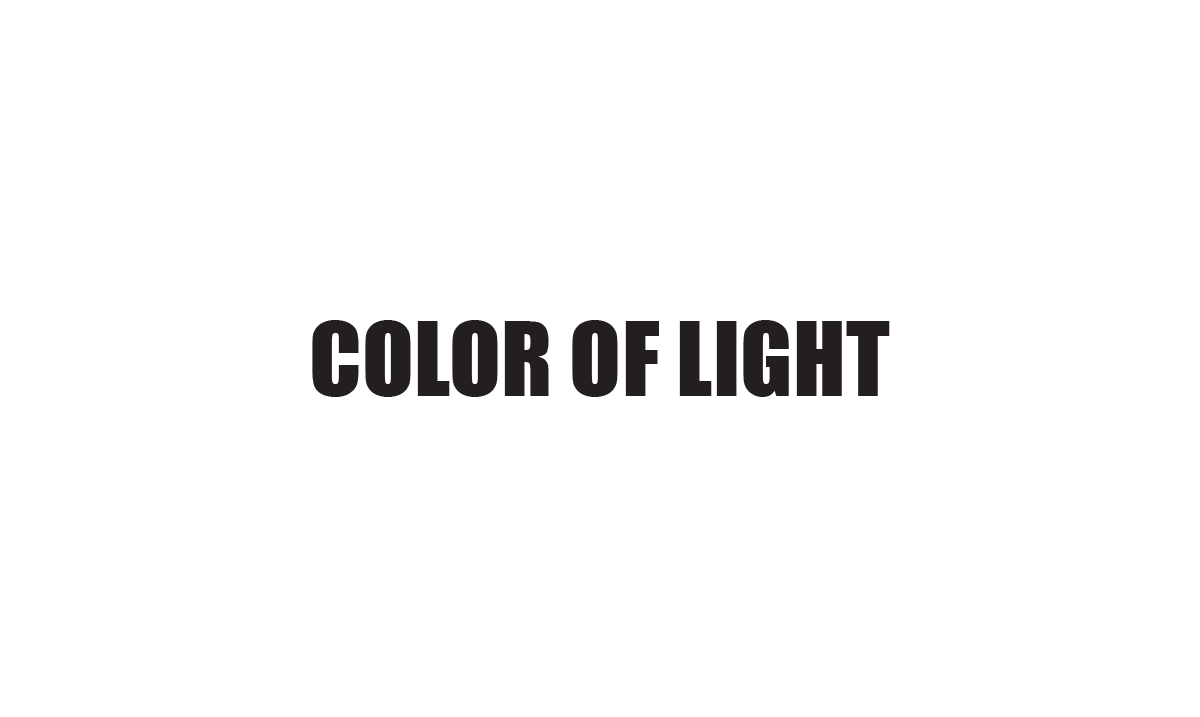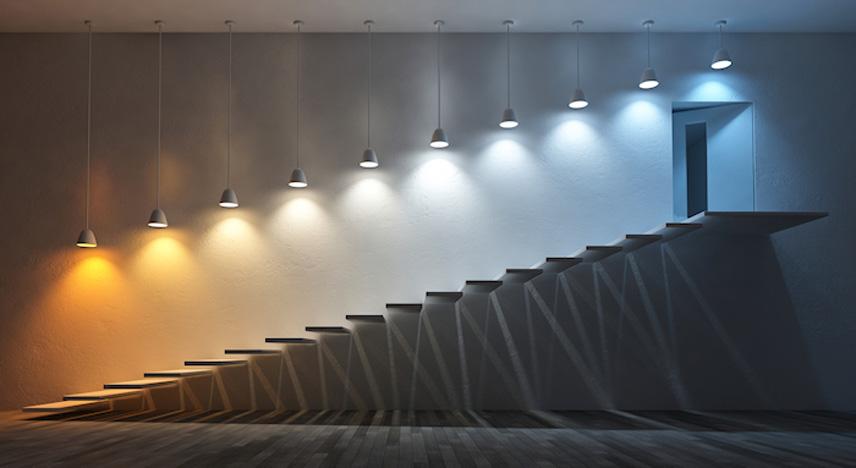Color temperature refers to a characterization of the spectral properties of a light source and is commonly used during the production phase in the film and photography industries. The color temperature of a light source is a numerical measurement of its color appearance. Color temperature is commonly described in degrees Kelvin (K), a unit of absolute temperature. Lower color temperatures generally are thought to be "warm" as they contain more yellow-red colors, while higher color temperatures generally indicate white light having a substantial blue component or a "cooler feel." By way of example, the CCT of an incandescent lamp is usually within the range of 2700 K-3300 K. Natural light sources include daylight with a relatively high color temperature (e.g., about 5000K). Color temperature is a measurement that indicates the extent of yellowish or bluish tint to a white light. High color temperatures are bluish while low color temperatures are yellowish. Of interest is that human vision compensates for these tints, and perceives both high and low color temperature lights as being white. It is only when two sources of different color temperatures are side-by-side that they appear different. There are, however, other subtle effects of these differences discussed in this article.

This measurement began in the late 1800s, when William Kelvin experimented with heat and a block of carbon. As the carbon heated, he noticed that it produced an array of colors as the temperature was increased. The heated carbon block first produced a dim red light and eventually a bright blue-white glow as higher temperatures were achieved. He noticed that with lower temperatures, most of the energy was converted to heat. Ever since Edison introduced us to the very first modern, prototypical, electric light bulb in 1879, we have seen everything illuminated by these incandescent bulbs in their Soft White color temperature, measured at 2700K (Degrees Kelvin). The light created by these bulbs has given off a slightly yellowish glow for over 130 years, making the colors in our homes feel warm and cozy the entire time.For this reason, choosing the right colour temperature for Led Lighting application is of great importance.
Still, this might be nice in bedrooms and living rooms, but what about in a bathroom, kitchen, basement, or garage, where you're trying to apply the right makeup, prepare food, play ping pong, or repair a bicycle tire? Sometimes, it's better to have truer, white lights, that show truer colors and more contrasts, with an overall "brighter" feel to them. With the advanced technology of Led Lighting now come in a vast range of color temperatures, providing many options to choose from when lighting the rooms in your home lighting or outdoor lighting applications.
The Range of Color Temperature
The three primary types of color temperature for Led Lighting are: Soft White (2700K – 3000K), Bright White/Cool White (3500K – 4100K), and Daylight (5000K – 6500K).
The higher the Degrees Kelvin, the whiter the color temperature. Although the whiter lights will appear "brighter" than those of a lower Kelvin reading, the amount of Lumens (measurement for brightness) does not change, and true brightness is not affected.
Kitchen Color Comparison, Soft White, 2700K vs Daylight, 5000K
Although our eyes have adjusted to the Soft White color temperature of incandescent bulbs over the years, this doesn't mean that they are necessarily the best option for all lighting applications. For example, because of their warmer color temperature, these soft white lights often pull warmer colors from a room (reds, oranges, etc.), altering the contrasts throughout the space. With that in mind, here are some tips on how to light the different rooms in your home most effectively:
 For interior led lighting in homes, especially in bedrooms and living rooms; Normally,we need “warm” colours they produce. So soft white/warm white will be more suitable for these lighting applications.
For interior led lighting in homes, especially in bedrooms and living rooms; Normally,we need “warm” colours they produce. So soft white/warm white will be more suitable for these lighting applications.
For some led lighting in kitchens, bathrooms or garages,Normally,we need giving rooms a whiter,more neutral white light.So bright white/cool white will be more suitable for these lighting applications.
For more industrial settings, and for higher intensity lighting ie. “high bay lighting, higher color temperatures of 4,500 to 5,000K are accepted. Metal Halide lights (HID) have traditionally been employed for this application, but of course Led Lighting are now available to do this job more efficiently.
For some specialty applications such as jewelery case lighting often use “cool” bluish lights of 6,500K or higher, in order to accentuate the sparkle and clarity of diamonds, silver and jewels.
The perceived feel of color groups is the psychological impact of lighting and directly affect people's choice on selecting the color temperatures of a luminaire. For people living in countries in the low latitudes where the climate is hot such as Thailand, Brazil, Kenya, and Indonesia, they may prefer lights with high color temperatures as these bring them a cool feel. Vice versa, in cold climate countries lights with low color temperatures are more popular. Neutral to cool color temperatures (4000-5000K) are generally appropriate in office space because they are refreshing and productive. Warmer color temperatures tend to work well in dining areas, guest rooms, and living rooms as they create a warm, inviting atmosphere which makes people feel relaxed. Consider lighting in the 2700-3500K range.

Color temperature has an enormous effect on our physical and mental well-being. The reason I do not recommend manufacturers to deliberately label in their product brochures the high color temperatures such as 6000-6500 K is for photobiological safety considerations. Advances in solid state lighting technology have contributed to the development of LED lighting with a satisfactorily high light output, making them an appealing alternative to incandescent or fluorescent lamps. However, the "white light" in LED lighting is typically produced by mixing the blue and the yellow light. Namely, a light emitting diode generates blue light and a phosphor emits yellow light in response to excitation by the blue LED output, whereby the blue and the yellow light, when appropriately mixed, produce light that is perceived as white light. To avoid the potential blue light hazard such as retinal injury, CCT over 6000 K should not be recommended for interior lighting by the Led Lighting manufacturer.
Color Temperature selection is widely a personal preference; each degree range will make a room feel a particular way, and in turn, will make the person IN the room perceive things differently. Most residential rooms are lit with warmer (orange/low) color temperatures to create a relaxed feel, and most commercial rooms are lit with cooler (blue/high) color temperatures to allow for a more alert environment.
Color temperature is often an aesthetic choice that depends on location and application. Fanguang Lighting are available in a variety of color temperature.We can guide you suitable color temperatures of LED lighting and their typical applications.We look forward to hearing from you.
Email:
[email protected]

 For interior led lighting in homes, especially in bedrooms and living rooms; Normally,we need “warm” colours they produce. So soft white/warm white will be more suitable for these lighting applications.
For interior led lighting in homes, especially in bedrooms and living rooms; Normally,we need “warm” colours they produce. So soft white/warm white will be more suitable for these lighting applications.